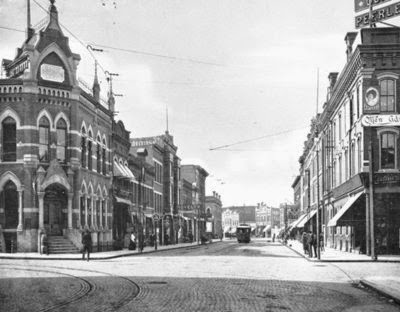Michel's Brewery
 |
| Michel Brewery 1857-1965 |
If La Crosse is often thought of by its historical minded natives first and foremost as a lumber town, its usually not far behind on that very same list that we think of it as a brewery city. It was mentioned in a previous Blue Collar that the lumber industry up and down the Mississippi (all of Wisconsin for that matter), was destined to run out of wood. Many mill towns at the turn of the 20th century went under or became mere shadows of their previous selves. The fact that La Crosse stayed afloat can be much attributed to its growing network of breweries. In 1894, La Crosse was the number one beer producing city in Wisconsin; in the year 1900 there were eight working breweries; "In 1906, the breweries employed 487 men; by 1914, 990 men were employed, an increase of over two hundred percent.' One such original site was Michel's Brewery, where Big Al's Pizzeria stands now
on third street downtown. Building-wise, although now unfortunately 'decorated' in a way that seems almost mocking of style, is of some architectural importance: "this building exhibits a mix of commercial Queen Anne and Italianate elements and has been described as Late Victorian Eclectic. Gustav Stolze and Hugo Schick had an architectural partnership from 1887 to 1889 and designed many of the extant late 19th century commercial buildings in downtown La Crosse, The C. and J. Michel Building exhibits strong architectural character and is an important contribution to the Third Street historic streets cape." From such humble beginnings, it could be said a brewing empire
 |
| Each letter indicating a building connected the La Crosse Brewery |
was being gradually built. In 1889, the entirety of the brewing facilities covered five acres, including a brewhouse, malt house, ice houses, bottle house, cooper shop, stables and an full ice making shop was built in 1888. "The annual capacity of the brewery in 1889 was seventy-five thousand barrels and the bottling department used seventy barrels per day [...] In 1919, when Prohibition went into effect,
the brewery changed its name to the “La Crosse Refining Company” and continued to operate by manufacturing malt and malt syrup. With the repeal of Prohibition in 1933, the brewery again started making beer, in addition to malt syrup. Its name was changed to “La Crosse Breweries, Inc. The Michel brothers bought the “Peerless” trademark and label the John Gund Brewing Company and started making “Peerless Peer.” On March 9, 1956, the Dahl Motors Company bought a 1/2 block tract of land from the brewery, containing its office, garage, and hospitality room. In 1958, the brewery was run by Theodore D. Solie. The firm closed in 1965."
As large, mass-production breweries now have to compete with unprecedented growth in the microbrewery segment, our own brew-rich history, as evidenced by old buildings and decrepit beer silos, would look to a visitor as if it, along with the lumber industry, was little more than a decaying reminder of our past. As many of the outgrowths of the breweries age as well – the taverns and "sampling rooms" themselves – and La Crosse continues to replace the old with the new, few will still be able to recall that Brewing once put us on the national map.

























